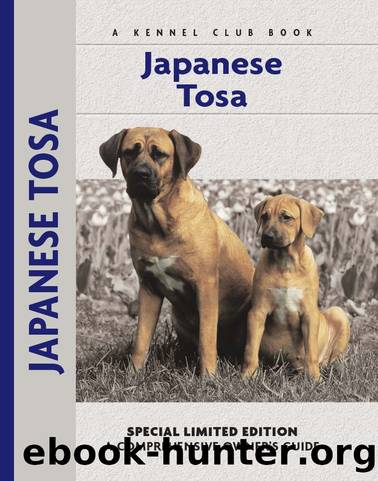Japanese Tosa by Steve Ostuni

Author:Steve Ostuni
Language: eng
Format: epub
Publisher: Lumina Media
Published: 2003-07-14T16:00:00+00:00
During the formative stage, 4 to 18 months of age, it is best to refrain from excessively vigorous exercise, as a Tosa’s bones, joints, ligaments and muscles are developing rapidly and are vulnerable to injury. Often a puppy’s bones will grow faster than the ligaments and muscles, which creates stress on the joints. Gentle exercise will strengthen muscles without causing injury.
Some breeders and trainers don’t recommend playing tug-ofwar with your Tosa. However, we have found it to be a stimulating activity for both dog and human if done correctly. Start your dog young and play gently, especially while your puppy is getting his adult teeth (four to six months of age). Let the pup win sometimes to build his confidence. When you play tug-of-war with a Tosa pup, make sure he understands that this is play. The first thing you must do is to teach him the “out” command so he will drop the tug toy on command. Discontinue the game if your dog gets too worked up; this is the time for a cool-down period.
Since they were bred as fighting dogs, Tosas have a natural desire to wrestle as puppies. They will wrestle and bite and that is completely natural. Let them explore their physical range with their littermates but do not let the biting behavior occur between you and the pup. Even at this age, your puppy can learn to distinguish what types of behavior is appropriate and with whom.
Most Tosas don’t play fetch naturally like retrievers, collies or spaniels. A few may use their strong prey drive to make the “fetch” into a wonderful game. Again be sure your Tosa knows that this is a game and not about possession of the toy. Your Tosa should let you reach for the toy or ball without any hint of possessiveness. Work with your pup so that he knows that he should not guard the toy possessively or show any aggression if someone attempts to take it away.
GROOMING
The Tosa is a wonderfully easy dog to groom because of his short coat. Periodic brushing with a natural bristle brush in the direction of the coat will remove loose hair and debris. Some Tosas develop a winter undercoat that sheds out in the spring. We find it helpful to use a horse shedding blade to remove the longer, finer winter coat. Tosas don’t shed a lot under normal circumstances, so if you notice unusual amounts of shedding, it may be a sign of allergies, skin conditions or illness, or even a need for essential fatty-acid supplementation.
Download
This site does not store any files on its server. We only index and link to content provided by other sites. Please contact the content providers to delete copyright contents if any and email us, we'll remove relevant links or contents immediately.
Finding Gobi by Dion Leonard(2779)
Grumpy Cat by Grumpy Cat(2680)
A New Earth: Awakening to Your Life's Purpose by Eckhart Tolle(2590)
The Silkworm by Robert Galbraith(2439)
Tippi by Tippi Hedren(2180)
End of Days by Sylvia Browne(2113)
Total Cat Mojo by Jackson Galaxy(1967)
Backyard Chickens Beyond the Basics by Pam Freeman(1902)
The Animals Among Us by John Bradshaw(1829)
The Ultimate Pet Health Guide by Gary Richter(1725)
All Things Bright and Beautiful by James Herriot(1704)
Vet in Harness by James Herriot(1663)
Doggy Desserts: 125 Homemade Treats for Happy, Healthy Dogs by Cheryl Gianfrancesco(1652)
Dog Years by Mark Doty(1642)
Cesar's Way by Cesar Millan(1632)
Chicken Soup for the Ocean Lover's Soul by Jack Canfield(1597)
Dog Training 101 by Kyra Sundance(1556)
Walking with Peety by Eric O'Grey(1551)
Animal Speak by Ted Andrews(1513)
